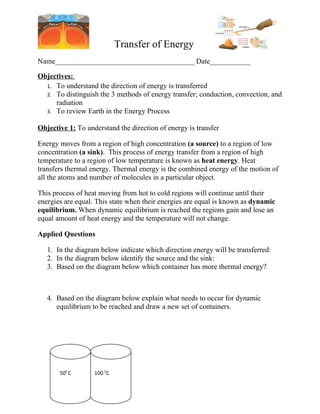
Transfer of energy
- 1. Transfer of Energy Name______________________________________ Date___________ Objectives: 1. To understand the direction of energy is transferred 2. To distinguish the 3 methods of energy transfer; conduction, convection, and radiation 3. To review Earth in the Energy Process Objective 1: To understand the direction of energy is transfer Energy moves from a region of high concentration (a source) to a region of low concentration (a sink). This process of energy transfer from a region of high temperature to a region of low temperature is known as heat energy. Heat transfers thermal energy. Thermal energy is the combined energy of the motion of all the atoms and number of molecules in a particular object. This process of heat moving from hot to cold regions will continue until their energies are equal. This state when their energies are equal is known as dynamic equilibrium. When dynamic equilibrium is reached the regions gain and lose an equal amount of heat energy and the temperature will not change. Applied Questions 1. In the diagram below indicate which direction energy will be transferred: 2. In the diagram below identify the source and the sink: 3. Based on the diagram below which container has more thermal energy? 4. Based on the diagram below explain what needs to occur for dynamic equilibrium to be reached and draw a new set of containers. 500 C 100 0C
- 2. Objective 2: Methods of Energy Transfer; Conduction, Convection and Radiation Heat is transferred from areas of high concentration (thermal energy) to areas of low concentration by three methods. These three methods are conduction, convection, and radiation. Conduction is the transfer of heat energy from vibrating atom to atom or molecule to molecule during collisions. Conduction typically occurs in tightly packed solids like a copper pipe, or bar of aluminum. Convection is the transfer of heat through movement in fluids, such as gas and liquids. This movement is caused by differences in densities within the fluid. Typically, hot fluids have lower densities than cold fluids. This process caused dense cold fluids to sink and hot less dense fluids to rise which set up a circulation cell. This allows oceans to circulate, winds to blow and is believed explain energy transfer in the Earth’s Mantle! Radiation is how energy is transferred through electromagnetic waves. No medium such as air or water is needed for electromagnetic eaves to travel. Electromagnetic waves can radiate through space. Radiation allows Earth to receive the Sun’s electromagnetic energy.
- 3. Questions: 1. Differences in density will cause what type of energy transfer? 2. What type of energy transfer allows Earth to receive the Sun’s energy? 3. What type of energy transfer does not require a medium? 4. What type of energy transfer allows us to see supernovas? 5. How is energy transferred in a metal pipe? 6. Explain why ocean circulation occurs? Try your best! 7. Explain why we have winds? Use your knowledge of density and energy transfers! 8. Explain the differences and similarities in the three types of energy transfer (at least 3 examples of each).
- 4. 9. Draw a diagram of a convection current (use a pot of water on a stove as an example).